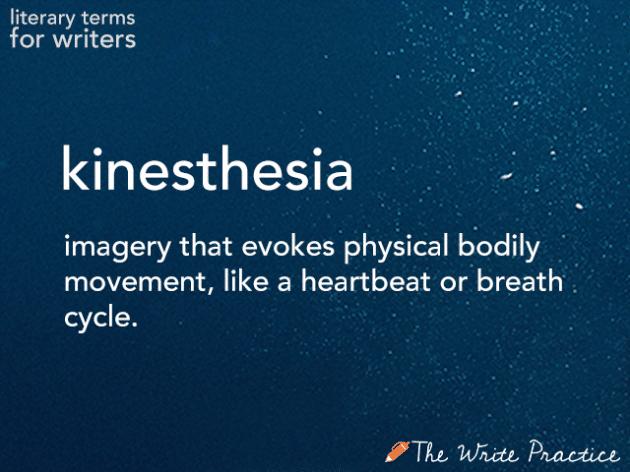It's kind of fun when words that refer to literary techniques have their origin in other disciplines. Take kinesiology, for example. I had several friends in college who were kinesiology majors, which means that they studied the science of human movement. That general idea of movement is also reflected in today's new literary word: kinesthesia.

What is Kinesthesia?
Kinesthesia looks like a linguistic blend of kinesiology and synesthesia, and the definition of kinesthesia isn't far off that mark.
The technical definition of kinesthesia is “awareness of the position and movement of the parts of the body by means of sensory organs (proprioceptors) in the muscles and joints.”
The literary definition of kinesthesia is similar: it's a type of imagery that evokes physical bodily movement, like a heartbeat or breath cycle.
How Does Kinesthesia Work, Practically?
Kinesthesia can be categorized into a few different types of imagery: touch, physical movement, temperature, or feelings.
Touch evokes physical contact and sensation, like the feeling of bare feet on a wood floor or shag carpet.
Physical movement is fairly self-explanatory: images of bodily movement are conjured.
Temperature might take the form of a brisk wind on a late fall evening, and feelings refer to imagery of emotions: happiness, anger, melancholy, etc.
How Can Writers Use Kinesthesia?
Kinesthesia is a simple way to appeal to your readers' senses and evoke powerful images from your words. It sparks the imagination of your readers as they visualize the motions of the scene you've just described, and makes your descriptions bolder and more evocative.
Much like synesthesia, kinesthesia builds your scenery and adds a sensory element to your prose, bringing your reader along with it.
Do you use kinesthesia in your writing? Share in the comments section.
PRACTICE
Spend fifteen minutes writing a nature scene, using kinesthesia to draw the movement from the natural world. Post your practice in the comments and browse the hard work of your fellow writers.







The small party of explorers gathers around a campfire at
the end of the day. The red and orange glow causes each person to place his
cold frozen joints in the warm wash of the fire. The scent of ash fills the air
as the fire eats up the burning wood. The taste of maple and pine smoke
conjures up images of home, where there are no giant cats or fierce wolves. Slight
crackles and pops echo amid the sound of the growing trees and the twilight
chatter of forest animals.
Overhead the sugar maples and towering pines creak and
groan, stretching to find the last golden drops of sun. Some say that these
sounds are the trees’ growing pains; the creak of wood is a sign that the tree
still grows upward. Branches sway in the wind, ruffling leaves and creating a
myriad of motion that disguises the squirrels returning home and the birds
returning to nest. Brief glimpses of color change the world from green and
brown to a kaleidoscope of colors. Red flashes of cardinals returning to pine
trees, the blue of bluebirds and jays, and the distinctive flash of yellow signaling
a finch returning to nest.
While the birds are returning to nest the flowers are going
to bed; the glorious bud are closing, morning glories and day lilies alike hide
their color in slow closing motions. In the morning the petals will open up
like a clam shell exposed to heat, slowly, slowly, until at last the flower is
revealed to all who wish to see.
Helaine, Nice job. I can visualize this from your imagery
Thanks! I liked yours as well.
Helaine, one of my favorite parts of your description is the trees creaking and groaning, stretching to find the last golden drops of sun. I also loved the glimpses of colorful birds flying home to their nests, and the idea of the swaying branches and ruffling leaves disguising the movement of the animals and birds.
From my WIP, a children’s novel set in the Midwest on the brink of the Great Depression. Mama and Papa are moving with their five children to northern Minnesota, where they hope to be able to survive hard times by living off the land. In this scene, Dorsey, a 12-year-old girl, is having breakfast.
Dorsey inhaled the rich aroma of fresh brewed coffee rising from the kitchen. A murmur of voices rose along with it. She pulled on her faded blue knickers and pink checked blouse, and burst into the kitchen like a sudden breeze.
Gram was cooking at the wood stove. She turned to ask, “How about some hot oatmeal with a dab of butter?”
“Yes, please,” Dorsey said. “Can I have some coffee, Mama?”
Mama sat at the kitchen table, her hands cupped around a steaming mug. Dorsey only got to drink coffee on special occasions.
“I’ll pour a little in your milk, but be sure to eat all your oatmeal,” Mama said. “We have a long, trip ahead of us today. We have to drive until we find a farmer who will pay us to help harvest his corn.”
Papa wiped the few remaining morsels of oatmeal from his bowl with his last bite of buttered toast, and popped it into his mouth.
Marilyn, I really like your Dorsey character! Bursting into the kitchen like a sudden breeze is a great way to describe her entrance. I’ll be interested to read along as your work progresses. I admire you for having a work in progress. I hope I can get there someday.
Thanks for the encouragement, AB. Your supportive comments gave me a real boost tonight.
The wolf paused, flicking its ears to check its surroundings. It breathed deeply, taking in the air, examining it for any evidence of pray. There was the aroma of petrichor, moist stone, and rotting leaves that always resided in this part of the forest. It breathed again, the fur on its belly moving with a gentle draft coming in from the east. He opened his mouth wide to be sure. Yes, there was blood intermingled with the dirt below him. He howled, calling his pack mates hidden in the brush. One by one they emerged like ghosts, from behind trees and brooks and empty dens. Their alpha began to move north, silently beckoning his pack to follow. Mud flattened under their paws, seeping between their toes. Their paw-steps were merely a whisper of wind on the forest floor, blending with the rustle of spruce tree branches and gurgle of the brooks. The smell grew thicker, exciting them. Eyes brightened and faded in time with the discovery of each red pool growing wider and wider. Deer, it said. Fresh by the warmth of the smell. The other wolves took up their positions, dispersing to flank and surround the ill-fated creature.
A branch cracked behind the Alpha. It was something that was not familiar with the forest or its secrets. A few wolves began to whine when they smelled it. The stench of burnt sulfur stung their noses along with the smell of tanning leather. The cracks continued, growing louder, louder. The alpha’s mate began to spin in circles, clearly aggravated by something. She stopped and whimpered, imploring her mate to lead them away. Others followed her example, whining and barking softly to attract his attention. They did not see what the alpha saw, a strange creature with the colors of the woods on his skin, standing on two legs with an odd stick in his hand. The alpha watched as the two-leg lowered his stick until the large end was in the space between its upper legs and chest. The black end lowered until it was level with the white star between his eyes.
The alpha’s mate saw the creature’s stick shoot backwards into its shoulder blade. She saw a small spray of red and smelled that awful sulfuric smell. Then she watched as the alpha’s legs fell under him and he hit the muddy ground, his white star stained red. She howled, in mourning and in warning. The pack began to run, ears flat, tails streaming behind them. Loud roars like thunder followed them with the howls and shrieks of slower, older members. Their legs burned like the fires of summer as the smell of blood and death surrounded them. More creatures, more sticks, no escape.
I love your description! It is so well placed that I can (almost) feel my own heart beat faster at the idea of the hunt
AGREED! 🙂
You have some great imagery, Lauren. Your verbs are well chosen and very active – rustle, gurgle, spin, whimper. I too felt the urgency of the alpha’s mate as he led the pack into danger.
Great post! Perfect prompt for me today. I got to use this as my practice, Vocabulary homework, and add it on to my NaNoWriMo novel!
Calixto woke up in a forest in the earliest
morning hours. Dawn was just breaking, and the light caused a fog to waft
through the trees. He looked up, and the trees seemed to stretch up ad infinitum,
branches intertwining with each other. The grass was pressing against his bare
arms and legs as he lay looking at the morning sky. A bright array of oranges,
reds, and yellows appeared, pushing the purple streaks of night away. Birds
started chirping, and the wind blew through the leaves above him, way above
him.
Dawn in a forest would be a lovely place to wake up! There is often fog around dawn as the mist rises off the low spots. I like your use of “waft” to describe the movement of the fog. You might consider having your character wander about a bit as a way of extending the movement idea.
Just joining you here – my first post. Looking forward to the motivation of daily practice!
Her breath was like a fog that hung around her face and
slowly wreathed off into the frosty air. Her footsteps crackled on the frozen
snow and she sank just a little with every step into the icy whiteness. She
stumbled a little as her foot slipped on a slick spot, but recovered and moved
a bit more slowly, feeling each step tentatively before trusting her weight
fully. It wasn’t far to the door, but in the subzero chill, a fall could mean
disaster. A light breeze sprang up, cutting through her clothing like a blade
of ice. It made the frozen tree branches rattle, and a skiff of old dead leaves
ghosted across her pathway. Almost there now…Putting her gloved hand on the
doorknob and giving a twist, she stumbled into the heavenly warmth of home.
I like the transition from cold to the warmth of the home!
Glad you are at the Write Practice!
Reading your post, I am glad that I am already in the warmth of my house. As someone who hates the cold, that is very similar to the image I get whenever the first round of frost arrives. Great post!
Thank you! It’s how I felt tonight when I finally got home from work 🙂
“slowly wreathed off into the frosty air.” Great image.
I’m wayyyy late on this one… oh, well, might as well post mine. I used this video at about 2:44 for inspiration – http://laughingsquid.com/awakening-a-stunning-4k-time-lapse-video-featuring-new-zealands-natural-landscapes/
White peaks atop sweeping green slopes. Soft gray clouds drifting between the mountains. A valley filled with tall, golden stalks, dotted with bursts of lavender and green. There, the boy stood, eyes closed, feeling the chill of wind competing with the intermittent wash of sun. His arms hung limply by his sides; his muscles were relaxed; his mind was a blank canvas. He allowed the softness of his surroundings to paint a picture for him. Though his eyes remained shut, he could see the breeze blowing the tall grass around his legs, playfully brushing against his fingers. He could see the patches of sunlight enveloping him in warmth and then going on their way. He could see the spots of blue traveling through the sky like birds. He could see the insects whizzing about his head, passing him by as if he were just another part of the landscape, a tree that had escaped its boundary on the mountainside.
Better late than never 🙂
I absolutely love this piece. I like the use of “he could see” several times in a row. It really gives a sense of peace!